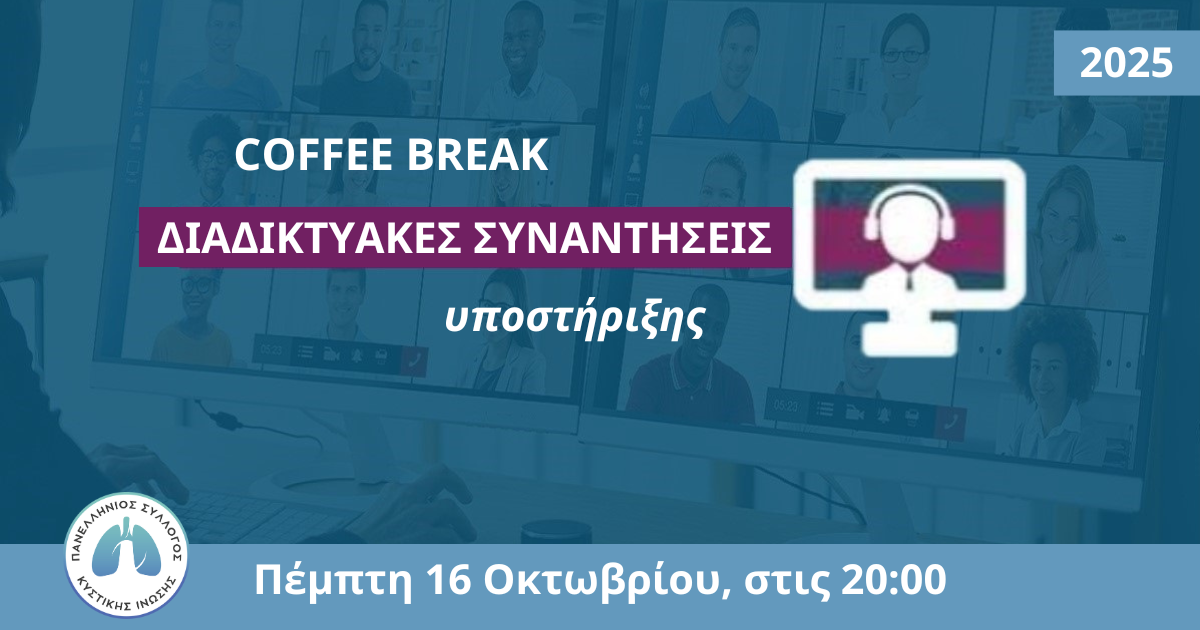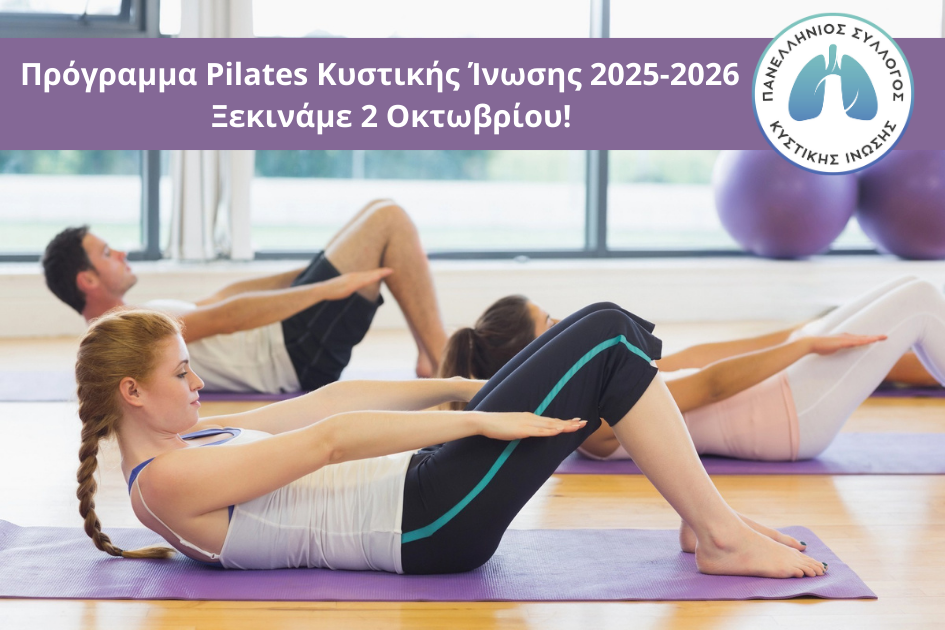In the year 2015, the medicine named ORKAMBI that targets patients with two copies of the DF508 mutation – a significant part of Cystic Fibrosis patients in Greece – is scheduled to be released in the market. In coming years, perhaps as soon as 2017, we might even have a combination of medicines that target patients with one copy of the DF508 mutation, affecting the majority of patients suffering from the disease.
Personalized exercising in Greece – important treatment method for Cystic Fibrosis
Innovative treatments that target the cause of a disease are a reality.
In the year 2015, the medicine named ORKAMBI that targets patients with two copies of the DF508 mutation – a significant part of Cystic Fibrosis patients in Greece – is scheduled to be released in the market. In coming years, perhaps as soon as 2017, we might even have a combination of medicines that target patients with one copy of the DF508 mutation, affecting the majority of patients suffering from the disease. At the same time, genetic treatments research is well underway, promising results in the future. However, all of these treatment options stop the progression of the disease, having no effect on any problems that might have already been caused, for example on the damage suffered by the lungs. Our main priority is to maintain the health of our patients, especially with regards to their lung function.
In our country, the mean survival time is 30 years, despite our having access to almost the entire range of medications available. The lack of specialized centers, specialities related to CF, awareness, etc. are some of the reasons that lead to that number. Our effort in recent years has led to significant improvement in the aforementioned areas on many levels.
There is a number of adult patients, however, who do not have the time to wait for new treatments.
Therefore, we succeeded in creating a new partnership with the AKH transplantation center in Austria, given that no lung transplantations take place in our country, as the final means of survival, showing our focus on immediate solutions. We also arranged for the organizing of conferences that targeted the training of physiotherapists and informing the public about the benefits of respiratory physiotherapy (an important treatment method). Furthermore, we focused on the importance of diet and personalized exercising to deal with the disease.
Talking with CF patients in other countries (such as the UK, Germany and Belgium) with a mean survival time that exceeded 40 years, we came to realise the degree of importance exercising has for their treatment routines. We thus asked for Dr. Tsanakas’ and Dr. Chatziagorou’s assistance from the 3rd Paediatrics Clinic of the Aristotle University of Thessaloniki, both of whom are active in the ongoing research regarding the disease in Europe and the CF centre in Thessaloniki is the only one that currently participates in the European Registry attempt, offers treatment at home.
In May, we organised a 3-day conference titled “Physiotherapy and exercising in CF” where amongst other things, a new and innovative exercising program from children was presented, with the collaboration of the CF centre in the Aristotle University of Thessaloniki unit in Ippokratio General Hospital, lead by Professor of Paediatric Pulmonology, Dr. Tsanakas, as well as the TEFAA department of the Aristotle University, under the Professor of Sports Medicine Dr. Deligiannis. The conference featured Alexandra Kramatz, a CF patient from Germany who presented a 5-year medicine, physiotherapy and exercise program that she went through, with incredible results, increasing her pulmonary function from 30% to 95%, “infecting” Greek patients with her enthusiasm and acting as an example for similar attempts in our country.
So 2 programs were created,
one for children with CF in Thessaloniki by the TEFAA department, along with the 3rd Paediatrics Clinic of the Aristotle university and one for adult patients with CF in Athens, at the 1st Pulmonological Clinic of Sotiria hospital, in collaboration with the laboratories in the “Thorax” Institute and the Sismanoglio hospital adult patients’ unit – both of which are supported by our association. The first results will be presented at the CF information day during the European CF Week 2015 that will be organized by our association, as has been the annual tradition.
As I personally participated in the adults’ unit, I feel the need to describe for the experience and my excitement from the first results. What impressed me the most, however, was that patients with reduced pulmonary function such as 30% FEV1(%) couldn’t possibly imagine that they’d be able to complete an exercise regime. For patients with reduced pulmonary function, so much as climbing a stair seems impossible, simply walking can lead to exhaustion and exercising seems like a joke. Every infection is simply a race to lose as less weight as possible, to keep pulmonary function above 30%, given that lower percentages are related to less survival time.
The first pleasant surprise we came across was the Respiratory Rehabilitation Unit of the Sotiria Hospital, where we met Rep. Professor of the University of Athens, Dr. Vogiatzis, President of the Respiratory Rehabilitation Unit of the European Pulmonology Association, a renown for their rehabilitation programs for CRP, for elderly people with extremely low pulmonary function measurements, similar to patients with CF. When we were introduced to the Professor of Pulmonology in the University of Athens and Head of the 1st University Clinic, Dr. Koulouris and we received permission to initiate the program, I was amazed to see elderly patients working hard and riding an exercise bicycle! Slowly at first, 10 minutes of cycling turned to 30, the intensity increased and exercise has turned in to a pleasant routine.
The secret to the impressive change was twofold.
The steady increase of duration and intensity for the exercises always took place with oxygen support. You were essentially receiving oxygen that you couldn’t possibly receive without external assistance, thus improving your stamina and your limits, exercising the body over the limited potential of a patient with 30% FEV1. The 2nd part is, however, perhaps the most innovative part of the program and it involved an “intermittent form of intense exercising”. The program was implemented with 30 seconds of intense exercise and 30 seconds of relaxation, for 30 minutes. During the relaxation periods, oxygen levels returned to their regular levels, thus aiding in improving the patient’s stamina and reducing the production of galactic acid in muscles. This form of exercise aids in the heavy training of peripheral muscles without depriving the body of oxygen. Furthermore, the feelings of heavy breathing and tiredness are under check, to allow for a longer duration for the exercise when compared to the steady load exercise that’s being implemented in most programs for CF patients.
The first results were more than impressive.
From the beginning of the 3-month program up to its completion, the increase of FEV1 in participating patients reached up to 10%, depending on the age, sex and disease progression (starting FEV1). Possibly the most impressive part was the difference in the FEV1 levels immediately before and after the exercise session. The improvement was between 10-25%. For example, a patient with 51% FEV1 before the exercise session was found to have had an increase that reached 62%!! Which means that the exercise effectively acted as a natural bronchodilator! There was also an increase in the max. oxygen consumption rate after the rehabilitation program, of up to 10%. The improvement in oxygen consumption is quite important, as similar studies in the past have shown that 60% of patients passed away within 8 years, compared to those who managed to increase their consumption rate. There was a delay in the anaerobic energy production of the body (increase of galactic acid), leading to an increased ability for exercise. Lastly, one patient gained 5 kg of weight, increased his muscle mass and reduced his level of kyphosis simply by exercising with the aid of machines inside his own home!
So, we’re pleased to announce that the first rehabilitation programs for children and adults in Greece are a reality. In September, we’ll organize new groups in order for every willing patient to participate, setting the tone for realising that exercise is an important treatment method for patients with CF, keeping them in the best possible physical state while they are in waiting for innovate treatments.
Dimitris Kontopidis
President of the Hellenic Cystic Fibrosis Association
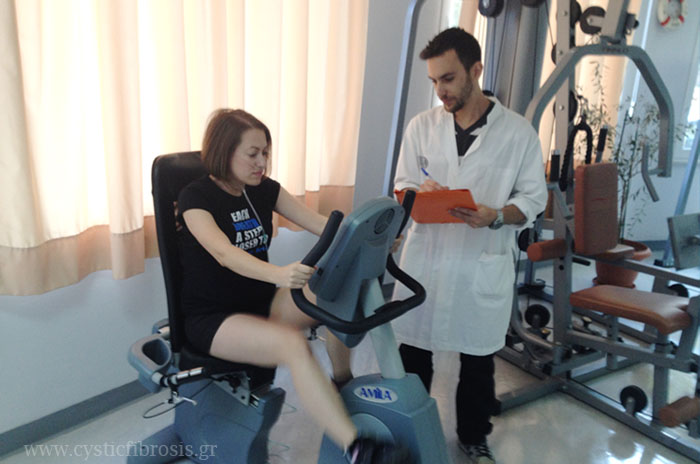

The innovative part of the study was the intermittent form of intense exercising. We implemented the program by providing 30 seconds of intense exercising and 30 seconds of relaxing for a duration of 30 minutes per session.
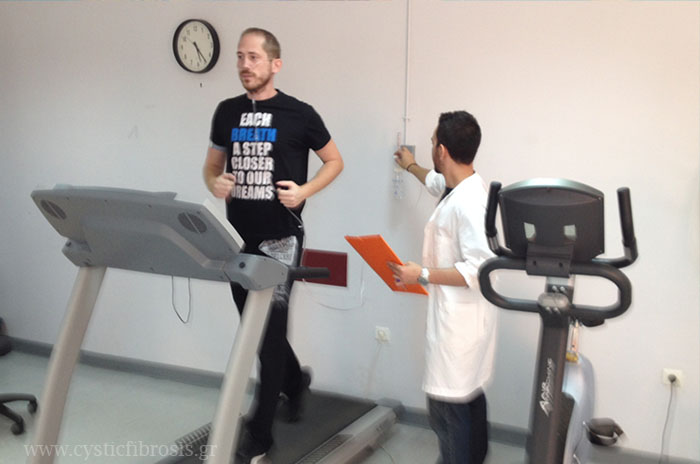

Incremental increases of the duration and intensity of the exercise were always complemented by oxygen support.
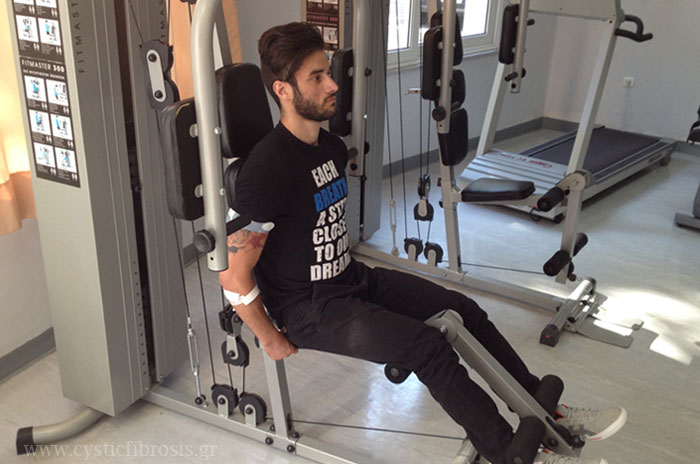

Quadriceps (the largest oxygen consuming group of muscles).
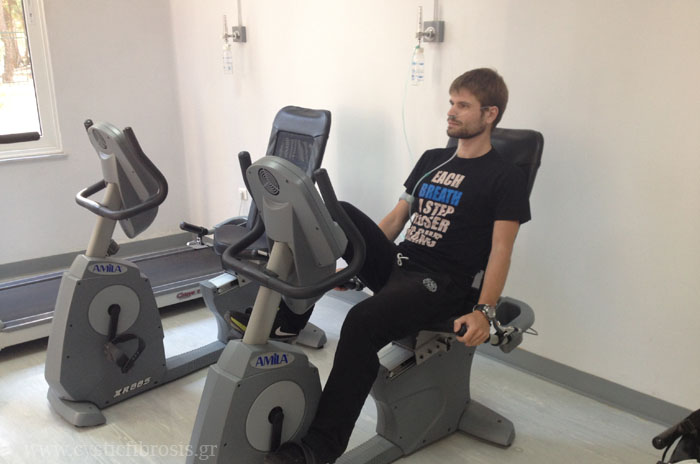

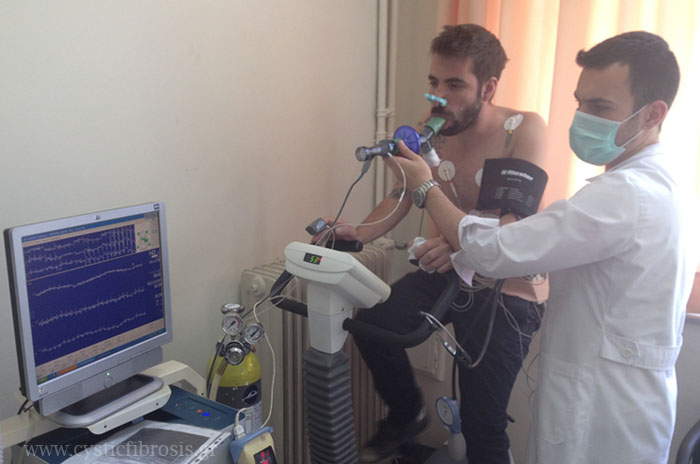

The increase of FEV1 in participating patients reached up to 10%, depending on the age, sex and disease progression (starting FEV1). The improvement between FEV1 levels before and after the session was between 10-25%. For example, a patient with 51% FEV1 before the exercise session was found to have had an increase that reached 62%!! Which means that the exercise effectively acted as a natural bronchodilator! There was also an increase in the max. oxygen consumption rate after the rehabilitation program, of up to 10%.

